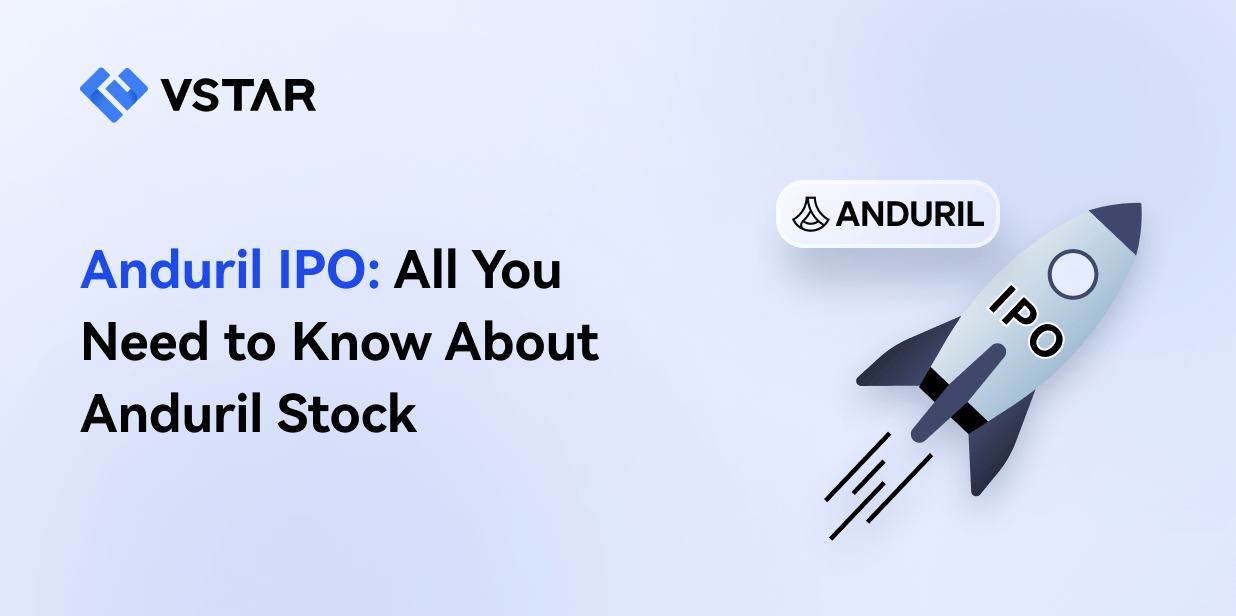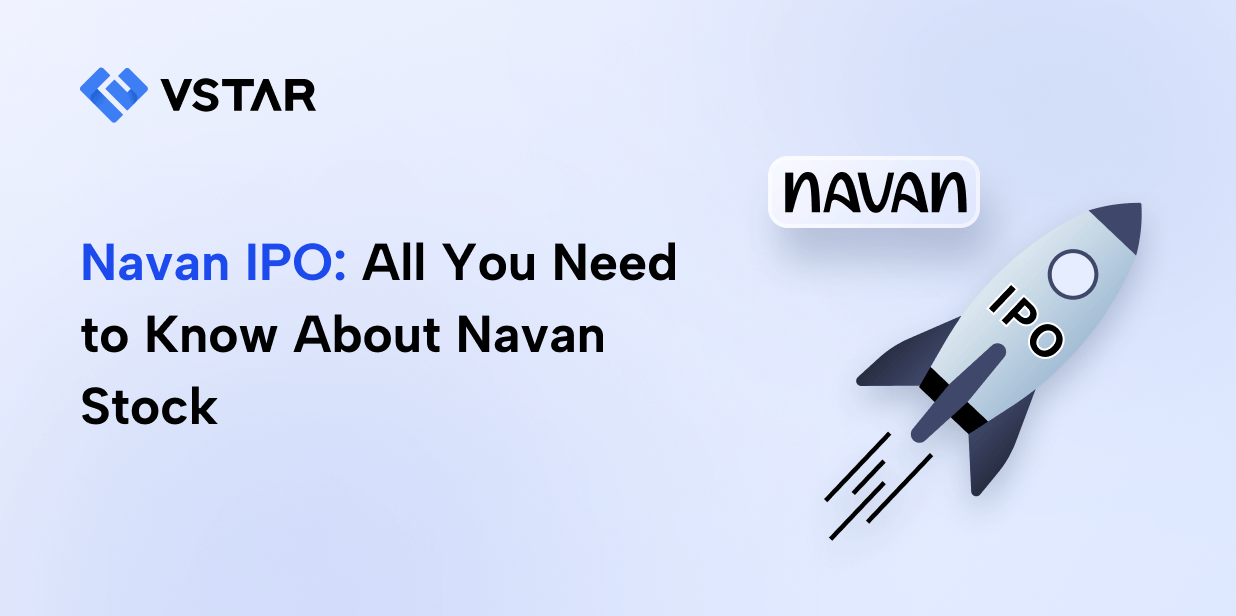Nike Inc. stands as an iconic American brand, synonymous with athletic excellence and global recognition. Its origin, stemming from Blue Ribbon Sports in 1962, showcased an early knack for performance-oriented products, which soon became essential for athletes and a part of the nation's jogging movement.
However, even a champion brand like Nike faced challenges, and in the second quarter of fiscal 2023, Nike reported earnings of $5.07 billion, down 16% from the previous year. Nike Earnings per share stood at $3.27, reflecting a 15% decrease, both falling short of analysts' projections.
Amid these challenges, Nike, a legacy company that has successfully adapted to changing market conditions, announced plans to gradually raise prices on certain products over the coming months, demonstrating the company's strong commitment to maintaining profitability.
In this article, we delve into the remarkable journey of Nike Inc., exploring its path from its humble origins, the challenges it faced, and how it turned adversity into a growth opportunity and brand mastery. Diving thoroughly into its history, financials, stock performance, and even suggested strategies for trading the NKE stock.
Nike Inc.: Tracing the Evolution of a Global Athletic Icon
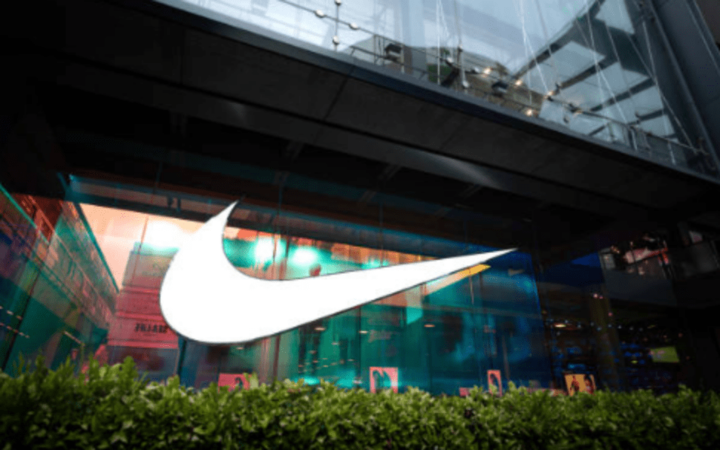
Image Source: Istock Photos
What is Nike
Nike Inc., founded by Phil Knight and Bill Bowerman in 1964, has emerged as a powerful symbol of athleticism, style, and innovation, with its iconic swoosh logo gracing sports arenas and streets alike. The company is headquartered in Beaverton, Oregon, USA, from where it orchestrates its global operations.
Nike's corporate structure is organized into three distinct segments: The Nike Brand, encompassing footwear, apparel, equipment, and accessories under the renowned Nike label; the Jordan Brand, synonymous with the legendary Michael Jordan and known for its exclusive line of footwear, apparel, and accessories; and Converse, known for its distinct cultural appeal.
The company's strategic vision is led by CEO John Donahoe, who assumed leadership in 2015, bringing his notable experience from his previous role as CEO of eBay. Nike's noteworthy shareholders shaping the company's trajectory include Vanguard Group Inc., BlackRock Inc., State Street Corporation, and Capital Research Global Investors.
They changed the name to Nike Inc. in 1972 and launched their first line of apparel in 1978. Nike went public in 1980 and thereafter signed a partnership agreement with Michael Jordan to create the iconic Air Jordan line in 1984. Nike introduced the visible air cushioning technology in Air Max shoes in 1987 and expanded into the hockey market with the acquisition of Canstar Sports in 1997.
Furthermore, Nike launched Nike Shox technology in 2000 for support and cushioning. As an eco-friendly brand, Nike released the lightweight and formfitting Flyknit technology in 2015 which reduces waste. In 2022, Nike committed to zero carbon and zero waste in their sustainability plan called 'Move to Zero'.
Nike Inc's Business Model and Products/Services
How Nike makes money

Image Source: Istock Photos
Nike generates revenue primarily through the sale of its products, including footwear, apparel, equipment and accessories under the Nike, Air Jordan and Converse brands In addition to product sales, Nike's licencing business empowers other companies to use its trademarks and logos to support its revenues. The company operates on a wholesale distribution model, selling its products to retailers, who then distribute them to customers. Nike also uses a direct-to-consumer strategy, selling products directly through its website and stores.
Nike's Main Products
Nike's core offerings include a wide range of products:
Footwear: As a global leader in athletic footwear, Nike offers a wide range of footwear suitable for sports and activities
Apparel: Nike's diverse range includes shirts, shorts, pants, jackets, and accessories, offering both style and functionality.
Equipment: The company offers a selection of sports equipment to meet the needs of players, from ball gloves to safety gear.
Accessories: To complement their product range, Nike offers accessories such as bags, watches, sunglasses, etc. that emphasize an active lifestyle
Image Source: Istock Photos
Nike's Services
In addition to those familiar products, Nike offers a number of services to empower consumers on their fitness journeys namely:
NikePlus Membership: Think of it as a VIP club for Nike fans. This membership allows you access to exclusive benefits: be the first to experience new releases, participate in special events, and enjoy personalized training programs.
Nike Training Club App: Just like having a personal wrist trainer. This completely free app offers a variety of workout routines and training programs designed by professional athletes and experienced trainers.
Nike Run Club App: A runner's essential companion, this app tracks your running, gets your own training, and does guided audio runs while watching athlete to keep you motivated.
Unveiling Nike Inc's Financial Health: A Comprehensive Review of its Financial Statements

Image Source: Istock Photos
Let's take a closer look at Nike's financial statements to understand its operations and financial strength.
Nike Market Cap
With a market capitalization of approximately $166.81 billion, Nike occupies an important position in the marketplace, demonstrating widespread acceptance and value.
Nike Market Share
NKE Earnings
Over the trailing twelve months, Nike generated revenue of $5.07 billion, yielding a positive return of 9.90%, demonstrating its solid profitability.
Revenue Growth: Nike's quarterly revenue growth (YoY) is 4.80%, indicating that it has been able to maintain a consistent upward trend, a key metric for sustainable growth.
Nike Return on Equity (ROE): Nike's ROE is an impressive 34.62%, indicating that the company makes effective use of shareholder equity to maximize returns.
Balance sheet health: Nike's balance sheet is noteworthy in several ways:
Total Cash Flow: With $10.68 billion in cash, Nike has a strong cash flow, which allows it to meet financial obligations and invest in growth opportunities
Total debt: Nike's total debt of $12.14 billion gives it a total debt ratio of 86.72%. Even if the company retains some leverage, this ratio must be monitored to ensure that it remains within manageable limits.
Current Ratio: The current ratio of 2.72 reflects a healthy financial position, reassuring investors that Nike will be able to meet its short-term obligations.
Cash Flow: Nike's trailing twelve operating cash flow is $5.84 billion, indicating that the company is able to generate revenue from its core operations.
Analyzing Nike's Valuation: A Comparative Review and Investment Considerations

Image Source: Istock Photos
When assessing Nike's valuation in comparison to its peers and the industry, several key financial ratios and metrics come into play. Let's delve into the numbers and analyze what they mean for potential investors.
Price-to-Earnings (P/E) Ratio: With a trailing P/E of 25.6, Nike's valuation is slightly higher than both its peers (22.3) and the industry (23.1). This suggests that investors are willing to pay a premium for Nike's earnings, possibly indicating perceived growth potential.
Price-to-Sales (P/S) Ratio: Nike's P/S ratio (3.6) is higher than both its peers (2.8) and the industry's (2.9), indicating that investors are valuing each dollar of Nike's sales at a premium compared to its competitors.
Price-to-Book (P/B) Ratio: Nike's P/B ratio (6.4) is higher than its peers (5.2) and the industry (5.4). This indicates that the market is attributing a higher value to Nike's tangible assets relative to its competitors.
Enterprise Value-to-EBITDA (EV/EBITDA) Ratio: Nike's EV/EBITDA (21.1) is again slightly higher than both its peers (18.7) and the industry (19.5), suggesting that investors are willing to pay a premium for Nike's earnings before interest, taxes, depreciation, and amortization.
These higher valuation multiples indicate that Nike might be slightly overvalued compared to its peers and the industry.
The Evaluation of Nike Stock: From IPO to Stock Price Performance and Analyst Forecasts
The Nike Stock Journey: From IPO to Dividends and Splits - A Comprehensive Look
Nike's first public offering (IPO) took place on December 2, 1979, marking a pivotal moment in the company's history.
Nike Ticker Symbol: Nike's primary trading is the New York Stock Exchange (NYSE), and the company's ticker symbol is NKE, an easily recognizable one in financial markets.
As a U.S.-based company, Nike's stock trades in US dollars, making it the dominant company in the US financially.
Nike stock trades on the NYSE from 9:30 a.m. to 4:00 p.m., Eastern Time (ET), offering investors plenty of trading opportunities. Pre-sales begin at 4:00 a.m. and end at 9:30 a.m. ET, while aftermarket trading begins at 4:00 p.m. and ends at 8:00 p.m. ET, Monday through Friday.
Nike Stock Split
Nike has had 12 stock splits since its IPO, reflecting the company's growth and commitment to shareholder value. The most recent stock split happened in 2020 with a 5-to-1 split, making the stock attractive to a wide range of investors.
Nike Dividend
Nike has consistently rewarded shareholders with dividends since 1983, reflecting the company's commitment to sharing its success. The dividend has grown steadily over the years, with a dividend yield of 1.24% in 2022, providing an attractive incentive for investors.
NKE Stock Price Performance and Forecast: A Closer Look
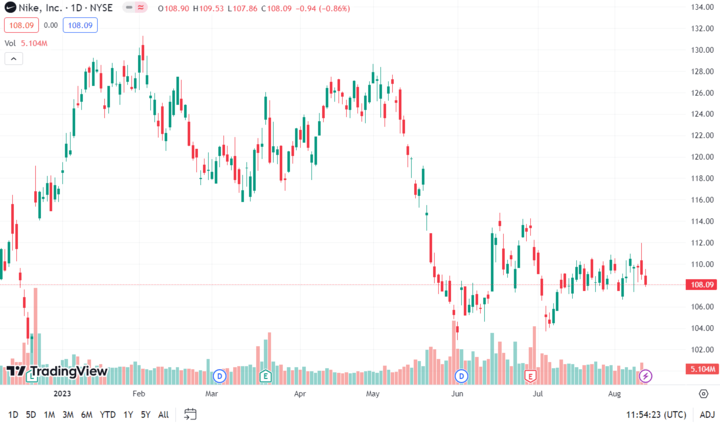
NIKE Stock Price Performance and Key Drivers
Nike Stock Price History: Nike stock has shown significant volatility since the IPO. The highest price was reached at an impressive $174.26 per share on November 5, 2021, marking a period of market improvement. At the other end of the spectrum was a record low of $2.50 per share, a milestone since December 8, 1985, indicative of the company's initial difficulties.
Current stock price: As of August 13, 2023, Nike stock price is $108.09 per share, which represents its current value.
Stock Price Volatility and Trends: Notably, Nike stock price has shown significant volatility in recent years, with trends pointing to a decline in 2021 from a notable high.
Key Drivers of the NKE Stock Price
Nike news like financial performance: Nike's consistently healthy cash flow, strong cash flow, and strong balance sheet contribute to the stability of its stock.
Market Leadership: As a leading global manufacturer of athletic footwear and apparel, Nike's strong brand and loyal customer base position it profitably in a growing market.
Global Economic Environment: A strong global economy frequently translates into increased consumer spending on sporting goods, which in turn affects Nike stock price.
Unlocking the Potential of NKE Stock: Resistance, Support, and Analyst Insights
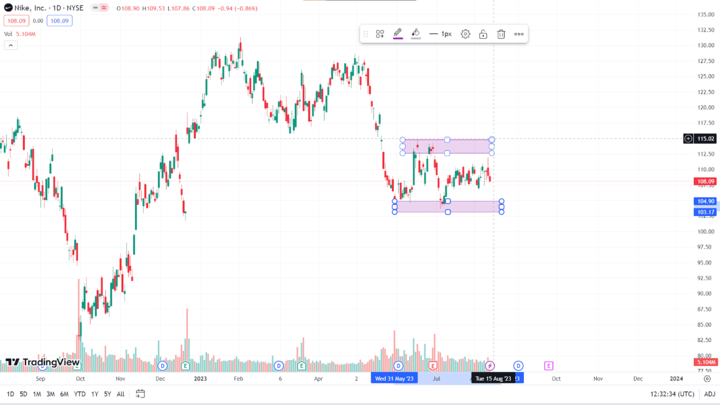
Based on TradingView data, NKE stock has resistance levels at $115.00, $120.00, and $125.00, posing challenges to the upside. We also note support levels for Nike share price at $100.00, $95.00, and $90.00, providing solidity when there is market volatility.
Nike Stock Forecast
So, is Nike a good stock to buy? Analyst opinion matters. Among 28 analysts, 20 ratings are "Buy", 5 are "Hold", and 3 are "Sell", revealing various opinions. Significant analysts have price targets. Morgan Stanley has a high price target of $135.00; Cowen indicates $130.00 with strong confidence; and Jefferies selects $125.00, conservatively positive.
The average price target is $126.58. The wide range, $150.00 highest and $88.00 lowest. Nike stock has the potential to rise (Implied Upside) by about 17% from its current price, but it also has the potential to fall (Implied downside) by about 8%.
NKE's Competitive Position: Risks, Opportunities, and Future Growth
Competitive Risks
Nike Competitors
Nike (NKE) faces intense competition from brands such as Adidas and Puma. Both Adidas and Puma are major players in the sports footwear and apparel industry, threatening NKE's market share. It is important for Nike to examine these competitors in order to understand the risks they pose.
Nike's competitive advantages
Nike has several competitive advantages that set it apart from its competitors. These include:
Brand Recognition
Nike is one of the most famous and recognized brands in the world. Its iconic logo and strong brand image give it a competitive edge.
Innovation and Technology
Nike invests heavily in research and development, enabling cutting-edge product development. Their focus on innovation and technological development gives them an advantage over their competitors.
Marketing and Advertising
Nike has a strong marketing and advertising strategy, that consistently delivers impactful campaigns that touch consumers. The ability to connect with the target audience through effective marketing provides a competitive advantage.
Global Presence
With a strong global presence, possessing outlets and partnerships in various countries. This global reach allows them to tap into different markets and target a wider range of customers.
Image Source: Istock Photos
Other risks
In addition to competition, Nike faces other risks that could affect its operations. These risks include:
Changes in Consumer Preferences
Consumer preferences and trends in the apparel and sportswear industries can change rapidly. Nike needs to lead this change and adapt its supply chain accordingly to avoid losing market share.
Supply Chain Disruptions
The global supply chain is vulnerable to disruptions such as natural disasters or political instability. Any disruption to Nike's supply chain could result in product delays or increased costs, affecting their profitability.
Currency Fluctuations
Nike operates in various sectors and reflects currency fluctuations. When translating revenue from one currency to another, fluctuations in exchange rates can affect the company's financial results.
Economic slowdown
A global economic slowdown could lead to a decline in demand for Nike's products.
Opportunities for Growth
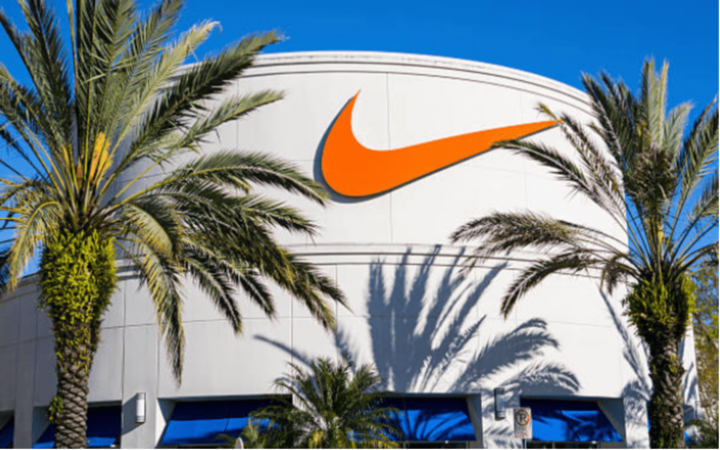
Image Source: Istock Photos
There are many growth opportunities for NKE to explore. Examples of growth opportunities for NKE include:
International Expansion:
NKE can focus on expansion into emerging markets with a growing customer base, such as China and India. These markets offer significant growth potential for NKE products.
E-Commerce Expansion:
The growing popularity of online shopping enables NKE to invest heavily in its e-commerce platform and digital marketing channels to reach more people and increase sales.
Trade diversification:
NKE may explore other product categories or networks to diversify its offerings. For example, entering the sports market or collaborating with famous athletes or influencers can attract new customers.
Nike's Future: Growth Through Strategic Expansion
Nike, the global powerhouse in sports shoes and apparel, is poised for a promising future. Here's how the company is expanding.
New market penetration: In 2022, Nike set up its first physical store in India, tapping into the growing fitness and sports market.
Digital identity: Nike is expanding its e-commerce presence in India, taking advantage of the accessibility and convenience of online channels.
Innovation Centre: A new research and development center in China will drive innovation, ensuring that Nike remains at the forefront of design and technology.
Production development: Nike is expanding production in China, increasing efficiency and flexibility to meet customer needs.
Why You Should Invest in NKE Stock
Traders should consider NKE stock for several compelling reasons:
Strong brand: NKE's globally recognized brand, a symbol of quality and innovation, gives it a competitive edge, which is attractive to investors looking for reliable growth.
Loyal customers: A committed customer willing to pay the premium ensures a steady stream of revenue, making NKE a stable investment.
Global presence: Operating in 170+ countries diversifies NKE's market, making it a convenient option for retailers.
Innovation: NKE's ongoing production innovation puts it at the forefront of the industry, resulting in increased sales and potential shareholder gains.
Sustainability: NKE's sustainability efforts align with current market requirements, positioning the company for potential future growth.
Growth Opportunity: NKE's strategies for e-commerce, direct-to-consumer, new market penetration, and continuous innovation offer a strategy to increase sales and profitability and drive its stock price in the dense.
Exploring Trading Strategies for NKE Stock

Image Source: Istock Photos
Navigating the challenges of NKE stock requires strategic prowess. How to buy Nike stock? Here's a closer look at some powerful strategies:
CFD Trading: Benefit from market movements
CFD trading (Contracts for Difference) is a dynamic strategy for traders aiming to profit from short-term price fluctuations of the NKE stock. It increases profits and losses and creates the power of leverage, which can be profitable but carries greater risk. The ability to short sell NKE stock provides a hedge or tool that seeks to profit from a down market. The liquidity of the CFD markets ensures easy position changes, making them perfect for taking advantage of short-term opportunities.
Option trading: controlled complexity
Options trading provides an attractive alternative, although it is more complex. Here, traders consider price trends in low-risk NKE stock. Unlike CFD trading, option contracts have a loss limit on the amount spent. Traders control gains and losses by selecting the price and expiration date. Many moves extend to hedging against stock market dips or capitalizing on a potential decline in NKE. However, it is important to note the increased risk.
Long-term investment leads to growth
For a more challenging and growth-seeking approach, consider long-term investments. This requires buying NKE stock with a multi-year horizon. It facilitates short-term adjustments, reduces the risk of loss, and matches the long-term growth in the portfolio. NKE's history suggests that if the company continues its growth trajectory, there is potential for higher returns over the long term. In addition, dividend payments provide a steady income stream.
Trade NKE Stock CFD with VSTAR: Elevate Your Trading
Diverse Trading Portfolio: Unlock the world of trading with a wide range of products, from stocks and currency pairs, commodities, indices, and cryptocurrency.
Seamless business experience: Benefit from top-notch business encounters. VSTAR provides market depth, efficient order execution, and customizable leverage options, all available in an intuitive and user-friendly trading app to ensure you never miss a market opportunity.
Transparent and cost-effective: Navigate clearly and enjoy transparent fees and remarkably low transaction costs, helping to optimize profits.Strong technical infrastructure: Your security is paramount. VSTAR's powerful technical foundation guarantees stability and security for your trades, allowing you to focus on your investments.
Regulatory Compliance: Rest easy knowing VSTAR strictly adheres to regulations, creating a transparent and fair trading environment and bolstering the security of your transactions.
Others: There are various other benefits, like a 24/7 multilingual customer service team and enhanced mobile trading with a wealth of tools, including chart analyzers, technical indicators, news, education, and so on.


Conclusion
In summary, NKE stock offers a compelling investment opportunity with its sturdy emblem, dependable customer base, and global reach. Despite facing competitive risks, NKE's benefits, such as innovation, sustainability efforts, and increased possibilities, make it an appealing choice for traders searching for both short-term gains and long-term capacity. Diverse buying and selling strategies, along with CFD buying and selling, alternatives trading, and long-term investment, permit buyers to tailor their method based on risk tolerance and investment goals. With Nike's commitment to consistent growth, market expansion, and ongoing innovation, the outlook for Nike company is still excellent.
FAQs
1. Is NIKE stock a Buy, Sell or Hold?
At the current price, which is below the 52-week high but above the low, Nike could be considered a potential buy for long-term investors. However, some may view it as a hold based on valuation and potential economic headwinds.
2. Does NIKE pay a dividend?
Yes, Nike pays a quarterly dividend to its shareholders. The current annual dividend rate is 1.46%, with a quarterly dividend amount of $0.37 per share.
3. What is the future prediction for Nike stock?
Analysts have an average 12-month price target of around $130 for Nike stock, implying potential upside from current levels based on expectations for Nike's brand strength and growth initiatives.
4. Where will NIKE stock be in 5 years?
If Nike continues to execute well, some analysts model the stock potentially reaching $150-$175 per share in a 5-year timeframe, driven by international growth and digital initiatives.
*Disclaimer: The content of this article is for learning purposes only and does not represent the official position of VSTAR, nor can it be used as investment advice.











